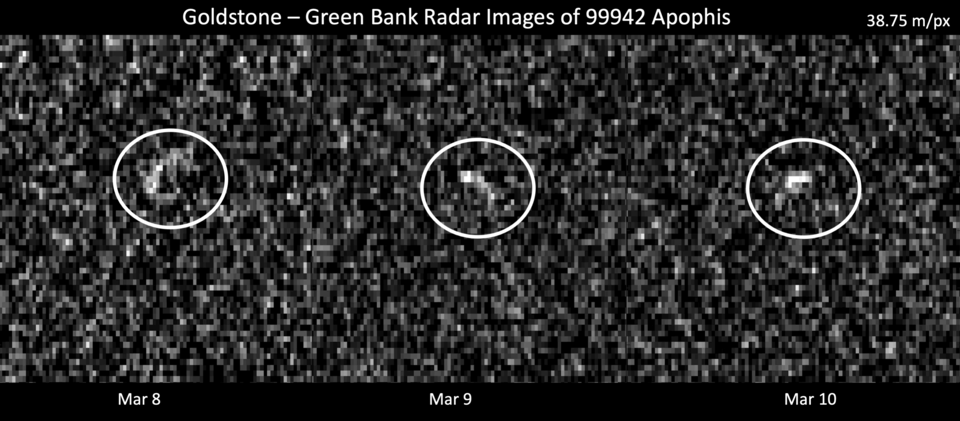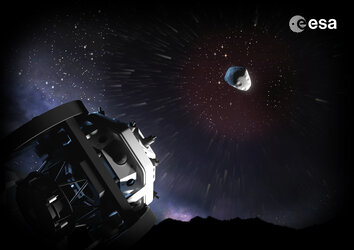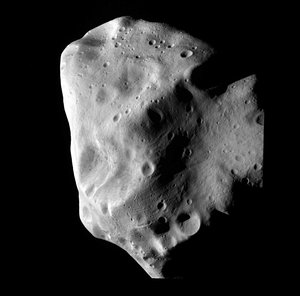Introducing Ramses, ESA’s mission to asteroid Apophis
30 years ago, on 16 July 1994, astronomers watched in awe as the first of many pieces of the Shoemaker-Levy 9 comet slammed into Jupiter with incredible force. The event sparked intense interest in the field of planetary defence as people asked: “Could we do anything to prevent this happening to Earth?”
Today, ESA’s Space Safety programme takes another step towards answering this question. The programme has received permission to begin preparatory work for its next planetary defence mission – the Rapid Apophis Mission for Space Safety (Ramses).
Ramses will rendezvous with the asteroid 99942 Apophis and accompany it through its safe but exceptionally close flyby of Earth in 2029. Researchers will study the asteroid as Earth’s gravity alters its physical characteristics. Their findings will improve our ability to defend our planet from any similar object found to be on a collision course in the future.
Apophis
Roughly 375 m across, about the size of a cruise liner, the asteroid Apophis will pass within 32 000 km from Earth’s surface on 13 April 2029. For a short time, it will be visible to the naked eye in clear, dark skies for around two billion people across much of Europe and Africa and parts of Asia.
Apophis will miss Earth: astronomers have ruled out any chance that the asteroid will collide with our planet for at least the next 100 years. But the Apophis flyby in April 2029 is an extremely rare natural phenomenon.
By analysing the sizes and orbits of all known asteroids, astronomers believe that an object this large comes this close to Earth only once every 5000 to 10 000 years. For comparison, a total solar eclipse takes place somewhere on Earth around once every 18 months, and Comet Halley returns to Earth’s skies every 76 years.
The 2029 Apophis flyby will draw the attention of the entire world and represents a unique opportunity for science, planetary defence and public engagement.
Ramses
ESA’s Ramses spacecraft will rendezvous with Apophis before it passes Earth and accompany the asteroid during the flyby to observe how it is warped and changed by our planet’s gravity.
Patrick Michel Director of Research at CNRS at Observatoire de la Côte d'Azur in Nice, comments: "There is still so much we have yet to learn about asteroids but, until now, we have had to travel deep into the Solar System to study them and perform experiments ourselves to interact with their surface.”
“For the first time ever, nature is bringing one to us and conducting the experiment itself. All we need to do is watch as Apophis is stretched and squeezed by strong tidal forces that may trigger landslides and other disturbances and reveal new material from beneath the surface."

Ramses needs to launch in April 2028 to allow for an arrival at Apophis in February 2029, two months before the close approach. In order to meet this deadline, ESA requested permission to begin preparatory work on the mission as soon as possible using existing resources. This permission has been granted by the Space Safety programme board. The decision whether to commit to the mission in full will take place at ESA’s Ministerial Council Meeting in November 2025.
Using a suite of scientific instruments, the spacecraft will conduct a thorough before-and-after survey of the asteroid’s shape, surface, orbit, rotation and orientation. By analysing how Apophis changes during the flyby, scientists will learn a lot about the response of an asteroid to external forces as well as asteroid composition, interior structure, cohesion, mass, density, and porosity.
These are all very important properties for assessing how best to knock a hazardous asteroid off a collision course with Earth. As asteroids are also time capsules formed over four billion years ago, data from Ramses will also offer new scientific insights into the formation and evolution of the Solar System.

NASA, meanwhile, has redirected its OSIRIS-REx spacecraft towards Apophis. Due to the limits of orbital mechanics, the newly renamed OSIRIS-APEX will arrive at Apophis roughly one month after the asteroid’s Earth flyby.
Researchers anticipate Earth's tidal forces altering the asteroid’s rotational state and possibly triggering quakes and landslides. Having Ramses there in advance will provide a detailed 'before and after' view of how Apophis has been altered by its close encounter. Then, in the aftermath, having two highly capable spacecraft at Apophis after the flyby will enable additional scientific investigations and the measurement of longer-term effects.
Rapid reconnaissance: a cornerstone for planetary defence
The international collaboration between NASA’s DART asteroid impactor and ESA’s Hera asteroid detective is demonstrating that, in principle, humankind can redirect an asteroid if needed. But to react to a real hazard, we need to be able to build and deploy a response quickly.
Richard Moissl, heading ESA's Planetary Defence Office, explains: “Ramses will demonstrate that humankind can deploy a reconnaissance mission to rendezvous with an incoming asteroid in just a few years. This type of mission is a cornerstone of humankind’s response to a hazardous asteroid. A reconnaissance mission would be launched first to analyse the incoming asteroid’s orbit and structure. The results would be used to determine how best to redirect the asteroid or to rule out non-impacts before an expensive deflector mission is developed.”
Paolo Martino, leading ESA's Ramses effort, adds: "The Ramses mission concept reuses much of the technology, expertise and industrial and science communities developed for the Hera mission. Hera demonstrated how ESA and European industry can meet strict deadlines and Ramses will follow its example."















 Germany
Germany
 Austria
Austria
 Belgium
Belgium
 Denmark
Denmark
 Spain
Spain
 Estonia
Estonia
 Finland
Finland
 France
France
 Greece
Greece
 Hungary
Hungary
 Ireland
Ireland
 Italy
Italy
 Luxembourg
Luxembourg
 Norway
Norway
 The Netherlands
The Netherlands
 Poland
Poland
 Portugal
Portugal
 Czechia
Czechia
 Romania
Romania
 United Kingdom
United Kingdom
 Slovenia
Slovenia
 Sweden
Sweden
 Switzerland
Switzerland








































